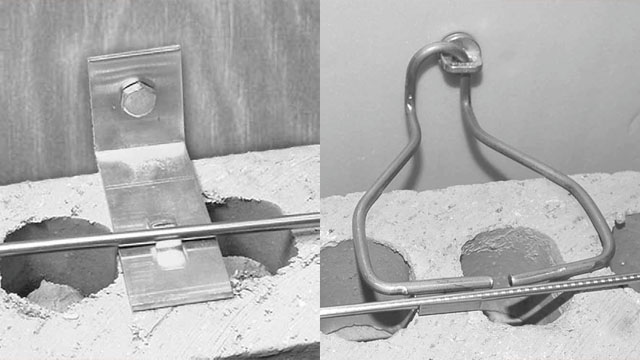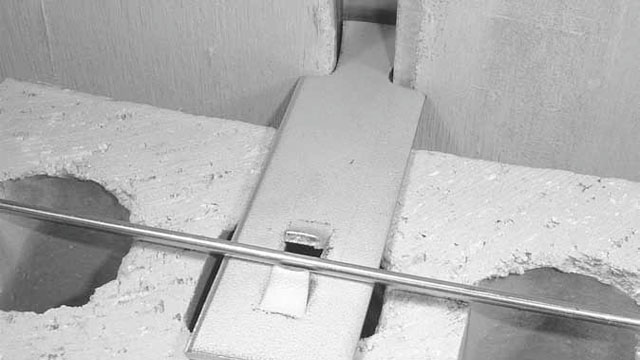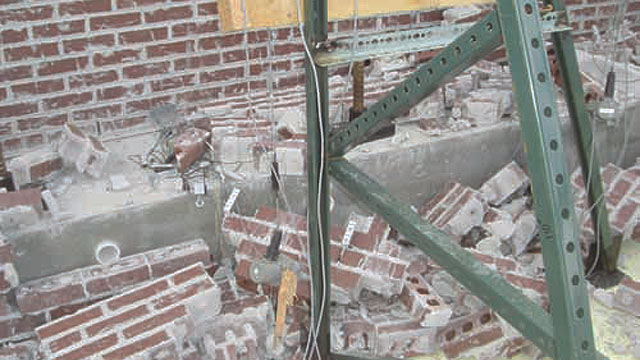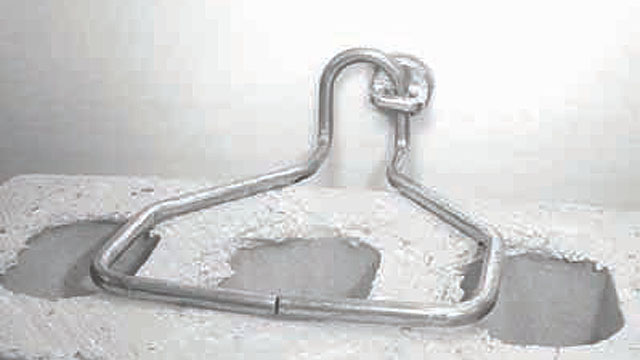November 3, 2010 8:05 AM CDT
Installing Seismic Anchors by the Code
Get masonry industry news in your inbox
Subscribe to Masonry Messenger to receive the masonry resources and information you need to stay current.
No Thanks
X
By
Paul Curtis
Millions of people live in high seismic zones in the United States. There are six seismic zones, labeled A through F. Zones A and B require no additional seismic anchoring requirements. Zone C requires the engineer to isolate the sides and top of anchored veneer from the structure, so seismic forces resisted by the structure are not imparted to the veneer. For Seismic Zones D, E, and F the International Building Code requires a single, continuous nine-gage (.156-inch or 5/32-inch) reinforcing wire in the horizontal mortar joint of brick veneer walls. This wire needs to be tied to the backup with an anchor and spaced with one anchor a maximum of every two square feet with a maximum vertical spacing of no more than 18 inches. Typically, you will find these anchors spaced every 16 inches on center. The Code also requires that the veneer anchors must be within 12 inches of wall edges near openings. The Brick Industry Association (BIA) recommends eight inches. Most seismic anchors have clips that are welded or clipped to wire anchors, and bent notches in flat anchors like the two shown below.

Most seismic anchors have clips that are welded or clipped to wire anchors, and bent notches in flat anchors.
It is critical that the nine-gage wire be engaged in the clip as shown above. The anchor should be centered in the mortar joint, with mortar above and below the anchor. Anchors must be a minimum of 1.5 inches into the veneer with a minimum mortar cover of 5/8-inch to the outside face of the wall. Neither the Masonry Standards Joint Committee (MSJC) nor the International Building Code (IBC) address the issues of splicing the nine-gage wire in the veneer. The National Concrete Masonry Association NCMA Tek Note 12-6 states that wire and joint reinforcement is typically spliced six inches (152 mm) minimum to transfer shrinkage stresses. The Uniform Building Code of 1982 stated that the seismic joint reinforcement shall be continuous with butt splices between ties. When properly installed, both the backup and veneer will share the out-ofplane load in proportion to their rigidities.

A typical two-piece seismic anchoring system.
Selecting the Correct Anchor for Your Wall
Bendable, corrugated wall ties have been around since the 1920s. By Code, they can only be used in veneers with wood-framed backups and the veneer airspace cannot exceed one inch.

This is a photo from an earthquake test done in January 2009 at UC San Diego’s Englekirk Structural Engineering Center.
The photo above is from an earthquake test done in January 2009 at UC San Diego’s Englekirk Structural Engineering Center. These corrugated wall ties were nailed to the backup. The nails pulled out of the wood studs causing failure of this wall. Corrugated wall ties should be installed with ring-shanked nails or wood screws. In another test performed by the Department of Civil and Environmental Engineering - University of Illinois at Urbana-Champaign 2.5-inch-long wood screws increased the average strength of the tie connection sub-assemblies by 150 percent over 8D nails (source: Newmark Structural Engineering Laboratory Dept of Civil and Environmental Engineering – University of Illinois at Urbana-Champaign: NSEL-016 August 2009 Seismic Performance of Anchored Brick Veneer by Dziugas Reneckis and James M. LaFave).

A typical two-piece anchor without seismic clips.
The Code requires two-piece adjustable anchor systems for steel stud, concrete, and CMU backup walls with brick veneers. You cannot use one-piece anchors for these backups. The anchor systems typically consist of a metal plate or barrel screw attached to the backup with a receptacle for a wire tie that goes into the veneer mortar joint. The two-piece systems allow for vertical adjustment for placement in the veneer. There is a maximum allowable lateral “play” between the two pieces of 1/16-inch. The two-piece anchors allow for deflection and differential movement between the two walls.
Originally published in Masonry magazine.
About the Author
Paul Curtis is president and third-generation owner of Heckmann Building Products, Inc. Heckmann has been manufacturing masonry anchors and ties since 1923.
Related Articles
More Masonry Headlines






















